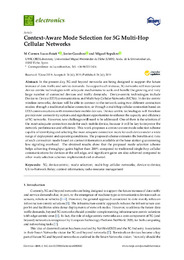Por favor, use este identificador para citar o enlazar este ítem:
https://hdl.handle.net/11000/5296Registro completo de metadatos
| Campo DC | Valor | Lengua/Idioma |
|---|---|---|
| dc.contributor.author | Lucas Estañ, María del Carmen | - |
| dc.contributor.author | Gozalvez, Javier | - |
| dc.contributor.author | Sepulcre, Miguel | - |
| dc.contributor.other | Departamentos de la UMH::Ingeniería de Comunicaciones | es |
| dc.date.accessioned | 2019-10-03T09:59:38Z | - |
| dc.date.available | 2019-10-03T09:59:38Z | - |
| dc.date.created | 2019-07-26 | - |
| dc.date.issued | 2019-10-03 | - |
| dc.identifier.issn | 2079-9292 | - |
| dc.identifier.uri | http://hdl.handle.net/11000/5296 | - |
| dc.description.abstract | In the present day, 5G and beyond networks are being designed to support the future increase of data tra_c and service demands. To support such increase, 5G networks will incorporate device-centric technologies with adequate mechanisms to scale and handle the growing and very large number of connected devices and tra_c demands. Device-centric technologies include Device-to-Device (D2D) communications and Multi-hop Cellular Networks (MCNs). In device-centric wireless networks, devices will be able to connect to the network using two di_erent connection modes: through a traditional cellular connection, or through a multi-hop cellular connection based on D2D communications with intermediate mobile devices. Device-centric technologies will therefore provide new connectivity options and significant opportunities to enhance the capacity and e_ciency of 5G networks. However, new challenges will need to be addressed. One of them is the selection of the most adequate connection mode for each mobile device, because it will be key to improve the network performance and e_ciency. This work proposes a context-aware mode selection scheme capable of identifying and selecting the most adequate connection mode for each device under a wide range of deployment and operating conditions. The proposed scheme estimates the benefits and risks of each connection mode based on context information available at the base station guaranteeing low signaling overhead. The obtained results show that the proposed mode selection scheme helps achieving throughput gains higher than 200% compared to traditional single-hop cellular communications for devices at the cell edge, and significant gains are also achieved compared to other mode selection schemes implemented and evaluated | es |
| dc.description.sponsorship | This work was supported by the Spanish Ministry of Economy, Industry, and Competitiveness, AEI, and FEDER funds (TEC2017-88612-R, TEC2014-57146-R) | - |
| dc.description.sponsorship | and the Generalitat Valenciana (GV/2016/049). | - |
| dc.format | application/pdf | es |
| dc.format.extent | 24 | es |
| dc.language.iso | eng | es |
| dc.rights | info:eu-repo/semantics/openAccess | es |
| dc.subject | 5G | es |
| dc.subject | device-centric | es |
| dc.subject | mode selection | es |
| dc.subject | multi-hop cellular networks | es |
| dc.subject | device-to-device | es |
| dc.subject | UE-to-Network Relay | es |
| dc.subject | context information | es |
| dc.subject | radio resource management | es |
| dc.subject.other | 621.3 - Ingeniería eléctrica. Electrotecnia. Telecomunicaciones | es |
| dc.title | Context-Aware Mode Selection for 5G Multi-Hop Cellular Networks | es |
| dc.type | info:eu-repo/semantics/article | es |

Ver/Abrir:
4-electronics-08-00840-v2 (1).pdf
2,71 MB
Adobe PDF
Compartir:
 La licencia se describe como: Atribución-NonComercial-NoDerivada 4.0 Internacional.
La licencia se describe como: Atribución-NonComercial-NoDerivada 4.0 Internacional.
.png)